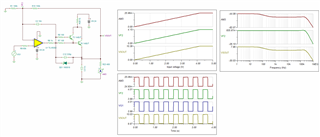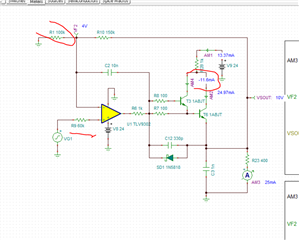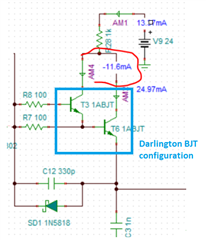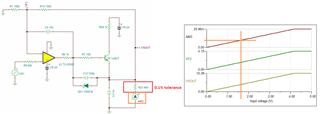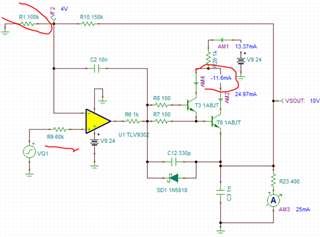Other Parts Discussed in Thread: TLV9302,
Tool/software:
Dear MR/MS,
We build a In-phase proportional amplifier with the TLV9302, the output of it connect to Base electrode of two BJT, all of these components make a voltage source. And we use the Tina to simulate the circuit, the circuit is as below. From the simulation results, we can see that the resistance value of the output load can reach a minimum of 400omh(R23).
But when the board in house, we test the actual circuit, when the load is 979omh, the circuit can’t work well, the test data as below, we can see the error rate of the output voltages will be bigger when the input voltage to be smaller . And the Vbe, V+, V- listed as below. It seems like the positive and negative voltages of the operational amplifier are not equal, and the virtual break cannot be established when the circuit can’t work well. What causes the V+ to be not equal to V- of the TLV9304? Is it due to insufficient driving capability of the operational amplifier?
|
input voltage value (V) |
Theoretical output voltage value (V) |
The tested output voltage value(V) |
Error rate |
+' Input of TLV9304(V) |
‘-' Input of TLV9304(V) |
output of TLV9304(V) |
Vb Of BJT(V) |
Ve Of BJT(V) |
Vc Of BJT(V) |
Vbe(V) |
|
4 |
10 |
10.052 |
0.52% |
3.9621 |
3.9988 |
10.671 |
10.626 |
9.997 |
18.338 |
0.629 |
|
2.4 |
6 |
6.256 |
4.27% |
2.377 |
2.3993 |
6.64 |
6.613 |
5.999 |
20.275 |
0.614 |
|
0.8 |
2 |
2.421 |
21.05% |
0.7909 |
0.8597 |
2.653 |
2.5763 |
2.435 |
22.653 |
0.1413 |
|
0.2 |
0.5 |
0.384 |
23.20% |
0.1962 |
0.1588 |
0.6137 |
0.7128 |
0.3809 |
23.73 |
0.3319 |
When We change the resistance of the load R23, we found that when the resistance bigger than 30k, the circuit works well. The below data is recorded when load is 166k. Why is there is such a big gap between the results of the actual circuit and the simulation? Is there something causing the operational amplifier to malfunction? Would u like to give us some suggestion?
|
input voltage value (V) |
Theoretical output voltage value (V) |
The tested output voltage value(V) |
Error rate |
+' Input of TLV9304(V) |
‘-' Input of TLV9304(V) |
output of TLV9304(V) |
Vb Of BJT(V) |
Ve Of BJT(V) |
Vc Of BJT(V) |
Vbe |
|
4 |
10 |
10.009 |
0.09% |
3.962 |
4.0043 |
10.498 |
10.501 |
10.01 |
23.878 |
0.491 |
|
2.4 |
6 |
6.001 |
0.02% |
2.3769 |
2.4009 |
6.49 |
6.495 |
6.002 |
23.899 |
0.493 |
|
0.8 |
2 |
1.997 |
0.15% |
0.791 |
0.7988 |
2.4837 |
2.4896 |
1.997 |
23.919 |
0.4926 |
|
0.2 |
0.5 |
0.497 |
0.60% |
0.1962 |
0.1987 |
0.9527 |
0.9529 |
0.4967 |
23.927 |
0.4562 |




